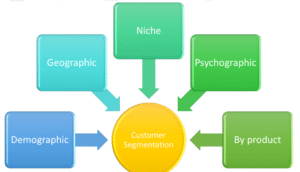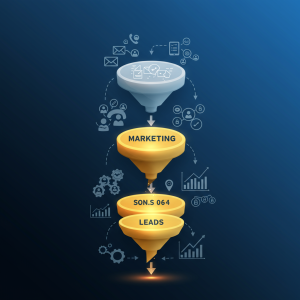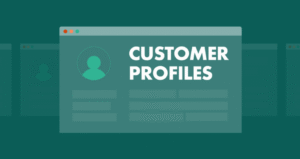Outbound Marketing for B2B: What Actually Works in High-Ticket Sales

Outbound marketing gets a bad reputation. Critics dismiss it as outdated, intrusive, or ineffective compared to inbound strategies. But here’s what they’re missing: when executed correctly, outbound marketing remains one of the most powerful tools for B2B companies selling high-ticket products and services.
The key difference lies in understanding that outbound marketing has evolved. Gone are the days of spray-and-pray cold calling or generic mass emails. Modern outbound marketing for high-ticket B2B sales is strategic, personalized, and data-driven. It’s about reaching the right decision-makers at the right time with the right message.
High-ticket B2B sales present unique challenges. Sales cycles are longer, multiple stakeholders are involved, and prospects need significant convincing before making substantial investments. This environment actually favors well-executed outbound strategies because they allow you to proactively engage with your ideal customers rather than waiting for them to find you.
In this comprehensive guide, we’ll explore the outbound marketing tactics that are actually moving the needle for B2B companies in high-ticket sales environments. You’ll discover proven strategies, real-world applications, and actionable insights you can implement immediately to drive more qualified leads and close bigger deals.
Why Outbound Marketing Thrives in High-Ticket B2B Sales
High-ticket B2B sales operate differently from other markets. Decision-makers aren’t typically browsing Google for solutions to problems they may not even realize they have. They’re busy running their businesses, focused on immediate priorities, and often unaware of innovative solutions that could transform their operations.
This creates a perfect storm where outbound marketing becomes essential. Your prospects need education, awareness, and often a compelling reason to change their current approach. Outbound marketing allows you to interrupt their routine with valuable insights and position your solution as the catalyst for growth they didn’t know they needed.
The longer sales cycles common in high-ticket B2B also work in favor of outbound strategies. You have time to nurture relationships, provide value through multiple touchpoints, and build trust gradually. Unlike low-ticket impulse purchases, high-ticket sales reward persistence and relationship-building—core strengths of effective outbound marketing.
Additionally, the smaller, more defined target market in high-ticket B2B sales makes outbound marketing more efficient. You can invest more resources per prospect because each conversion represents significant revenue. This economic reality makes the higher cost-per-contact of outbound marketing strategies not just viable, but often more profitable than broader inbound approaches.
The Foundation: Data-Driven Prospect Research
Successful outbound marketing starts long before your first outreach attempt. The foundation is built on thorough, data-driven prospect research that goes far beyond basic company information and contact details.
Modern prospect research combines traditional firmographic data with behavioral signals, technographic information, and intent data. You need to understand not just who your prospects are, but what they’re trying to achieve, what challenges they’re facing, and what might trigger them to consider a change.
Start by identifying your ideal customer profile with laser precision. Look beyond surface-level characteristics like company size and industry. Dig into the specific business challenges your solution addresses, the organizational structures that facilitate decision-making, and the timing factors that create urgency for change.
Leverage tools that provide insight into your prospects’ technology stack, recent investments, leadership changes, and growth indicators. Companies expanding into new markets, implementing new systems, or facing regulatory changes often represent prime opportunities for high-ticket solutions.
Social listening and content consumption tracking can reveal prospects who are actively researching problems your solution solves. These behavioral signals are goldmines for outbound marketers because they indicate current pain points and buying intent.
The goal is to build a comprehensive picture of each prospect that enables you to craft messaging that feels personal, timely, and relevant. Generic outreach fails in high-ticket B2B sales because sophisticated buyers expect vendors to understand their unique situation before requesting their attention.
Strategic Cold Email Campaigns That Convert
Cold email remains one of the most effective outbound marketing channels for B2B high-ticket sales, but only when executed with precision and strategy. The old approach of sending the same generic pitch to thousands of prospects is not just ineffective—it’s counterproductive.
Successful cold email campaigns for high-ticket sales focus on quality over quantity. You’re typically targeting smaller lists of highly qualified prospects with deeply personalized messages. Each email should feel like it was written specifically for that recipient, because it was.
The most effective cold emails for high-ticket B2B sales don’t pitch products—they start conversations. They lead with insights, industry observations, or specific challenges you’ve noticed in the prospect’s business. The goal is to position yourself as a knowledgeable resource before introducing your solution.
Timing plays a crucial role in cold email success. Align your outreach with business cycles, industry events, or company-specific triggers like funding announcements or leadership changes. An email sent at the right moment can feel like perfect timing rather than random interruption.
Follow-up sequences are where many high-ticket campaigns succeed or fail. Decision-makers are busy, and a single email rarely generates an immediate response. However, a persistent, value-driven follow-up that continues to provide insights and builds on previous messages can break through the noise.
The key is varying your approach across follow-ups. Mix different types of value—industry reports, case studies, introductions to relevant contacts, or invitations to exclusive events. Each touchpoint should reinforce your expertise while providing standalone value.
Social Selling: LinkedIn as Your Primary Channel
LinkedIn has become the dominant platform for B2B outbound marketing, particularly in high-ticket sales environments. The platform’s professional context, advanced targeting capabilities, and built-in relationship-building tools make it ideal for reaching decision-makers with complex purchasing processes.
Effective LinkedIn outbound marketing starts with optimizing your personal and company profiles as relationship-building assets. Your profile should position you as a trusted industry expert rather than just another salesperson. Share insights, comment thoughtfully on prospect posts, and build your presence before initiating direct outreach.
LinkedIn’s Sales Navigator platform provides sophisticated targeting capabilities that allow you to identify prospects based on precise criteria, including job changes, company growth, and engagement with specific types of content. These triggers often indicate openness to new solutions and strategic changes.
The connection request becomes your first impression, so make it count. Reference specific content they’ve shared, mutual connections, or industry developments relevant to their business. Generic connection requests with immediate sales pitches are instantly recognizable and typically ignored.
Once connected, focus on building genuine relationships before introducing your solution. Comment on their posts, share relevant content, and look for ways to provide value without asking for anything in return. This approach builds trust and positions you as someone worth knowing rather than another vendor pushing a product.
LinkedIn messaging for high-ticket sales should feel conversational rather than transactional. Reference their business challenges, industry developments, or recent achievements. The goal is to start a dialogue that naturally evolves into a discovery conversation.
Account-Based Marketing for Enterprise Prospects
Account-based marketing (ABM) represents the pinnacle of strategic outbound marketing for high-ticket B2B sales. Instead of casting a wide net, ABM focuses your resources on a small number of high-value target accounts with comprehensive, multi-channel campaigns.
The ABM approach recognizes that enterprise sales involve multiple stakeholders with different priorities, concerns, and information consumption preferences. A successful ABM campaign reaches each stakeholder through their preferred channels with messaging tailored to their specific role and interests.
Start by identifying your highest-value target accounts based on potential deal size, strategic importance, and probability of success. These accounts warrant significant investment in research, content creation, and personalized outreach across multiple channels and touchpoints.
Map the stakeholder landscape within each target account. Identify decision-makers, influencers, and end-users who will affect the purchasing decision. Understanding the internal dynamics and relationships helps you orchestrate a campaign that builds consensus rather than creating internal conflict.
Develop account-specific value propositions that address the unique challenges and opportunities facing each target company. Generic messaging fails in ABM because enterprise buyers expect vendors to understand their specific situation and demonstrate relevant expertise.
Coordinate outreach across multiple channels, including email, LinkedIn, direct mail, phone calls, and even targeted advertising. The goal is to create a cohesive experience where prospects encounter consistent, relevant messaging regardless of how they interact with your company.
Phone Outreach That Opens Doors
Phone outreach might seem outdated in our digital world, but it remains incredibly effective for high-ticket B2B sales when executed skillfully. The key is understanding that cold calling for complex sales isn’t about closing deals over the phone—it’s about opening doors to meaningful conversations.
Successful phone outreach for high-ticket sales focuses on securing meetings rather than delivering complete sales presentations. Your goal is to generate enough interest and credibility to earn 15-30 minutes of the prospect’s time for a proper discovery conversation.
Preparation separates effective phone outreach from amateur cold calling. Research each prospect thoroughly and develop a clear understanding of their likely challenges and priorities. Reference specific company developments, industry trends, or mutual connections to demonstrate that this isn’t a random call.
The opening seconds of your call determine success or failure. Lead with something that immediately demonstrates value and relevance to their business. This might be an insight about their industry, a question about a challenge you’ve observed, or a reference to a recent company development.
Focus on asking thoughtful questions rather than delivering monologues about your solution. High-ticket prospects are sophisticated buyers who can spot amateur sales tactics immediately. Demonstrate genuine curiosity about their business and challenges.
Handle objections with empathy and additional value rather than aggressive pushback. When prospects say they’re not interested, ask what would need to change for them to consider exploring new approaches to their current challenges. Often, this question reveals timing issues rather than a fundamental lack of fit.
Content Marketing That Supports Outbound Efforts

Content marketing amplifies every aspect of your outbound marketing strategy. High-quality, relevant content provides the value that makes prospects willing to engage with your outreach and positions you as a trusted expert throughout the sales process.
Develop content that addresses the specific challenges and interests of your high-ticket prospects at different stages of their buyer’s journey. Early-stage content should focus on industry trends, strategic challenges, and thought leadership that demonstrates your expertise without explicitly promoting your solution.
Case studies become particularly powerful in high-ticket B2B sales because prospects want to see evidence of success with similar companies facing comparable challenges. Develop detailed case studies that tell complete stories about how you’ve helped clients achieve significant results.
Use content strategically in your outbound campaigns. Reference relevant articles, reports, or case studies in your outreach messages. Offer exclusive content as a reason for prospects to engage with you. Create content specifically for individual high-value prospects when pursuing enterprise accounts.
Thought leadership content establishes your credibility and provides reasons for prospects to pay attention to your outreach. Regularly publish insights about industry developments, strategic challenges, and innovative approaches that demonstrate your expertise and forward-thinking perspective.
Interactive content like assessments, calculators, or planning tools can provide immediate value while generating qualified leads. High-ticket prospects often appreciate tools that help them evaluate their current situation or quantify potential improvements.
Measuring Success: KPIs That Matter in High-Ticket Sales
Measuring outbound marketing success in high-ticket B2B sales requires different metrics than traditional marketing campaigns. The longer sales cycles, smaller prospect pools, and higher deal values demand a more nuanced approach to tracking and optimization.
Start with leading indicators that predict future success rather than focusing solely on closed deals. Response rates to outbound campaigns, meeting acceptance rates, and progression through your sales pipeline provide early signals about campaign effectiveness.
Track engagement quality, not just quantity. A single high-quality conversation with a perfect-fit prospect is more valuable than dozens of brief interactions with poor-fit contacts. Measure the depth and progression of relationships rather than just initial response rates.
Pipeline velocity becomes crucial in high-ticket sales where individual deals can take months or years to close. Track how quickly prospects move through your sales stages and identify bottlenecks that slow progression. Effective outbound marketing should accelerate the sales process, not just fill the top of the funnel.
Customer acquisition cost must be measured over the full sales cycle, including all touchpoints and resources invested in nurturing prospects. High-ticket sales justify higher acquisition costs, but you still need to understand the full investment required to win each customer.
Lifetime value calculations become particularly important in high-ticket B2B sales where customers often expand their relationships over time. Factor in the potential for account expansion, renewal revenue, and referrals when evaluating the success of your outbound marketing investments.
Building Your Outbound Marketing Engine
Creating sustainable success with B2B outbound marketing in high-ticket sales requires building systematic processes rather than relying on individual efforts or random activities. Start by documenting your ideal customer profile with specific, measurable criteria that guide all your outbound efforts.
Develop standardized research processes that ensure consistent quality in prospect intelligence gathering. Create templates and checklists that help your team efficiently gather the insights needed for personalized outreach while maintaining high standards across all campaigns.
Build content libraries that support your outbound efforts with relevant, high-quality materials for different stages of the buyer’s journey and various stakeholder types. Having the right content readily available enables more personalized and valuable outreach at scale.
Implement technology tools that streamline your outbound processes without sacrificing personalization. CRM systems, email automation platforms, and social selling tools can increase efficiency while maintaining the human touch essential for high-ticket sales success.
Establish regular review and optimization cycles that continuously improve your outbound marketing effectiveness. Analyze what’s working, identify areas for improvement, and test new approaches systematically rather than making random changes based on anecdotal feedback.
Train your team not just on tactics and tools, but on the strategic thinking required for successful outbound marketing in complex sales environments. The ability to understand prospect challenges, craft relevant messaging, and build genuine relationships can’t be automated—it requires skilled professionals supported by effective processes and tools.
High-ticket B2B outbound marketing succeeds when it focuses on starting meaningful conversations rather than pushing products. The companies that master this approach create sustainable competitive advantages that drive consistent growth even in challenging market conditions. By implementing these strategies systematically and measuring results carefully, you can build an outbound marketing engine that consistently delivers high-quality opportunities for your sales team.
Learn more: Tap into the Outbound Email Marketing





